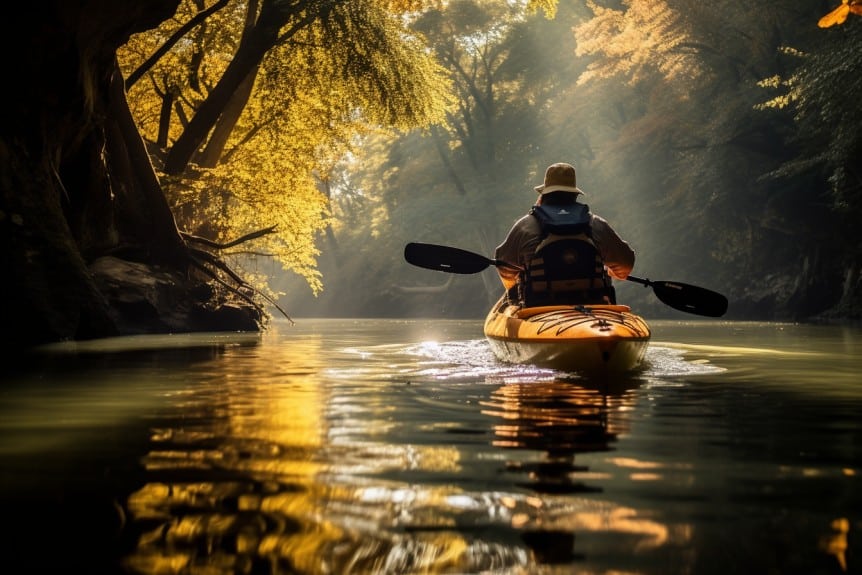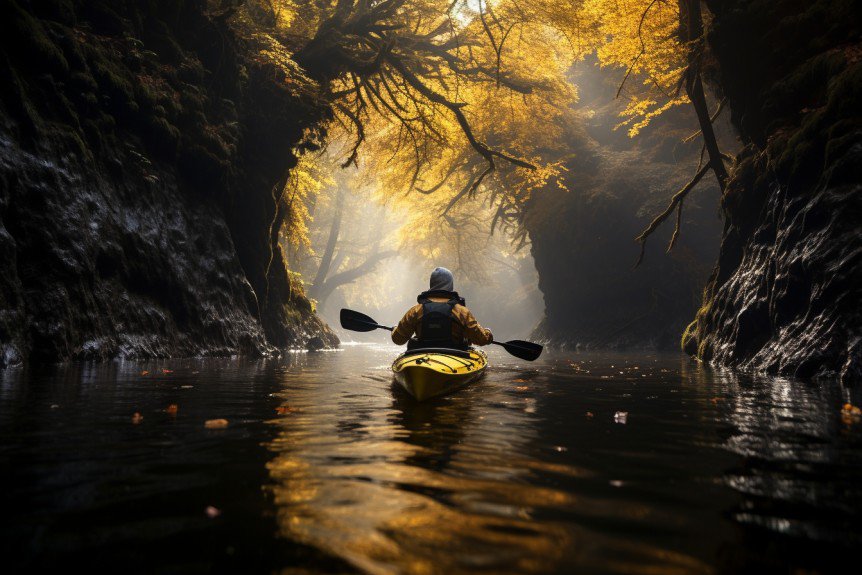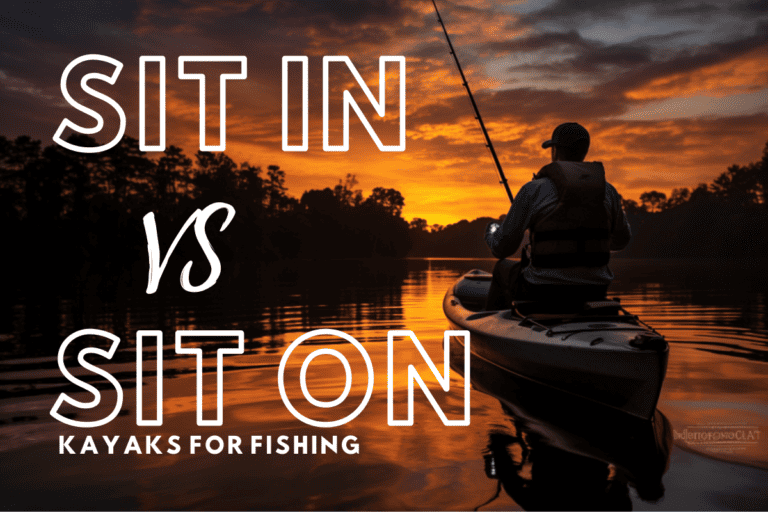Breaking it Down: Fishing Kayak Vs Regular Kayak

You’re up a creek without a paddle if you can’t distinguish between a fishing kayak and a regular one. Don’t worry, we’ve got your back!
In this article, you’ll discover the key differences, importance of structure, size, stability, storage solutions, propulsion systems, and even color variations.
You’re about to become a kayak connoisseur, helping you fit right in with the pros. Let’s dive in!
Fishing Kayak VS Regular Kayak: What’s the Difference
There’s a significant difference between fishing kayaks and regular ones, and it’s all about their specific designs and features catered to their intended uses. When you’re in the midst of the ‘fishing kayak vs regular kayak’ debate, let’s break it down and make it easier for you to understand.
| Fishing Kayak | Regular Kayak | |
| Purpose | Tailored for angling activities. Prioritizes features beneficial to fishing. | Designed for general paddling and recreation. |
| Design & Features | Equipped with rod holders, gear tracks, specialized storage, and seating designed for extended periods. | Minimalist design with basic storage options. No specialized features for fishing. |
| Size & Structure | Typically around 14ft long with a width of about 35 inches for stability. | Varies in size, often longer and sleeker for speed and agility. |
| Stability | Designed for primary and secondary stability. Broader hull for better weight distribution. | Prioritizes speed and maneuverability over stability. |
| Storage Solutions | Ample storage options tailored for fishing gear and catches. | Basic storage compartments, not designed for specialized gear. |
| Propulsion Systems | Options for pedal propulsion systems or trolling motors. | Primarily relies on paddling. |
| Color Variations | Dull or camouflaged colors to blend with surroundings. | Brightly colored for visibility and safety. |
Fishing kayaks are designed with a particular purpose in mind: to enhance your fishing experience. These specialized watercraft prioritize stability, allowing you to confidently stand and cast your line. They also feature ample storage space for your gear and catches, and may even include rod holders and other fishing-specific accessories.
On the other hand, regular kayaks are built more for general use. They’re typically designed with speed and maneuverability in mind, perfect for those who love the thrill of slicing through water or navigating around obstacles. Their streamlined design might not offer as much stability or storage, but it’s ideal for fast and agile paddling.
So, if you’re wondering about the ‘fishing kayak vs. regular kayak: what’s the difference?’, it’s really all about your intentions on the water. If you’re an angler looking for a kayak that can accommodate your fishing needs, you’d likely prefer to use a fishing kayak. However, if you’re seeking speed and maneuverability over fishing features, a regular kayak would better suit your needs.
Key Features of Fishing Kayaks
In terms of storage, fishing kayaks are equipped with a variety of options like mesh pockets, hatches, and tank wells to accommodate your gear. These key features offer you a sense of belonging, as every piece of equipment has its own place. No more fumbling around for your tackle box or bait; everything is within arm’s reach, allowing you to focus on the joy of the catch. Here is a list of typical features of a fishing kayak.
- Rod Holders: Essential for keeping multiple fishing rods within reach.
- Gear Tracks: Allow for the attachment of various equipment without drilling.
- Specialized Storage: Compartments tailored for fishing gear and accessories.
- Adjustable Seating: Designed for comfort during extended periods on the water.
Now picture this: You’re out on the water, your fishing rod poised for action. You don’t need to juggle your rod because your fishing kayak comes with molded-in or mounted rod holders, keeping multiple rods handy. It’s a game-changer.
But the comfort doesn’t stop there. The seating is typically designed with your comfort in mind. Imagine sitting for hours on the water, with the enhanced back support and cushioning easing any discomfort. Some models even allow adjustments for standing or reclining, so you can stretch out and enjoy your fishing trip just the way you like it.
And let’s not forget about the gear tracks. No more drilling holes in your beloved kayak. You can easily attach your equipment, including your essential fish finder, to these tracks. Hard chines, another key feature, offer better stability in choppy waters, making your fishing experience a safer one.
Your fishing kayak is more than just a vessel; it’s a companion that’s got your back, whether you’re a newbie or a seasoned angler. It’s time to embrace the features that make it uniquely yours.
How Fishing Kayaks are Structurally Different

When it comes to a fishing kayak vs regular kayak, there are several unique features that set them apart. Let’s dive in and examine how fishing kayaks are structurally different.
| Feature | Fishing Kayak | Regular Kayak |
|---|---|---|
| Length | Typically around 14ft | Varies, often longer for speed |
| Width | About 35 inches for stability | Sleeker design |
| Hull Design | Flat hull with multi-chin construction | Designed for speed and agility |
| Type | Predominantly sit-on-top | Both sit-inside and sit-on-top |
First off, fishing kayaks are typically longer, around 14ft in length. This additional length ensures they’re maneuverable in narrow channels and can reach secluded fishing spots regular kayaks can’t. Their width is equally impressive, often about 35 inches. This extra width provides stability, which is crucial when you’re trying to reel in a big catch. You wouldn’t want to capsize just as you’ve hooked a prize fish, would you?
Moreover, the broader hull of a kayak for fishing allows it to support more weight. This is essential as it needs to accommodate you, your fishing gear, and your successful catches. A regular kayak might struggle with the extra load, but a fishing kayak is designed to handle it.
The choice between sit-inside or sit-on-top is another key difference in fishing kayaks. The sit-on-top style is more popular among anglers due to its flexibility and space. It allows you to move around freely, which is essential when you need to adjust your position quickly to kayak fish. It’s all about making your fishing experience as comfortable and efficient as possible.
In essence, the structural differences of a fishing kayak are all about enhancing your fishing experience. They’re designed with you, the passionate angler, in mind. Now, doesn’t that make you feel like you truly belong on the water?
The Importance of Size and Structure in Kayaks
Can’t underestimate the impact of size and structure on a boat’s performance, particularly when it comes to stability and maneuverability. When choosing your type of kayak, you might find yourself torn between a regular kayak and a recreational kayak. Let’s delve into the importance of size and structure in kayaks to help you make an informed decision.
Regular kayaks, often chosen by experienced paddlers, are designed for speed and agility. They’re longer and narrower, which helps them slice through the water with ease. However, their sleek design might make them a bit tricky to handle if you’re new to the sport.
On the other hand, a recreational kayak – usually wider and shorter – might be your go-to choice if you’re just starting out or if you aim for a leisurely paddle. They offer greater stability, making it easier for you to get in and out or even fish.
The structure of the kayak, particularly the hull design, plays a significant role in its performance. A flat hull with multi-chin construction ensures primary stability in calm waters and secondary stability in rough waters. This balance is especially crucial in fishing kayaks, allowing you to stand or move around without tipping over.
You’re not just buying a kayak; you’re joining a community of enthusiasts who share your love for the water. Understanding the importance of size and structure in kayaks can help you find your perfect fit, enhancing your experience and ensuring you feel right at home on the water.
The Role of Stability in Fishing Kayaks

Stability is your top priority when you’re on the water aiming for that big catch, and certain design elements can really make a difference. When it comes to the fishing kayak vs the regular kayak debate, the stability factor easily tips the scales in the former’s favor. As an angler, you need a craft that lets you stand, move, and make fishing maneuvers with ease. That’s where the design of fishing kayaks shines, with elements like a broader, flatter hull and multi-chin construction providing a rock-solid platform. Here’s a quick breakdown of the features that contribute to stability.
- Hull Design: Flat hull with multi-chin construction for primary and secondary stability.
- Width: Broader design for better weight distribution and stability.
- Additional Features: Outriggers or stabilizers to enhance stability.
Fishing kayaks offer you the stability necessary to cast your line confidently, even in rough water conditions. The specialized features of these vessels create what’s known as primary stability for calm waters and secondary stability for when things get choppy. That’s the kind of assurance you need to feel like you truly belong out there, among fellow anglers.
Moreover, this stability isn’t just for safety—it enhances your fishing experience. You can focus on the thrill of the catch, rather than worrying about tipping over. So whether you’re engaging in recreational fishing on a lazy Sunday or competing in a local tournament, a fishing kayak’s stability is a game-changer.
Storage Solutions in Fishing Kayaks
In addition to stability, there’s also the matter of storage solutions in your marine craft that make your angling adventures more organized and hassle-free. You’ll find that fishing kayaks come with more storage options than regular kayaks. This setup ensures that everything you need, from rods to your catch, is within arm’s reach, making your fishing experience seamless.
- Mesh Pockets: For easy access to small tools and tackle.
- Hatches: Sealed compartments for storing valuables and electronics.
- Tank Wells: Open storage areas, often at the kayak’s rear, for larger items.
- Dedicated Compartments: Tailored storage for specific fishing gear.
Now, picture this: you’re out on the water, the sun is shining, and the fish are biting. The last thing you want to worry about is where to put your gear. That’s where fishing kayaks come into the picture. They come equipped with ample storage solutions, from large cargo areas to dedicated compartments for gear. This design is all about making your life easier on the water.
Remember, the goal here is convenience and efficiency. You’ll appreciate the accessibility and organization of storage spaces in fishing kayaks. You won’t be fumbling around looking for your gear or finding a spot for your catch. Everything has its place, and everything is within reach. That’s the beauty of fishing kayaks.
Propulsion: Different Kayak Systems

You’re probably aware that the propulsion systems in marine crafts have significantly evolved, allowing you to navigate the waters with greater ease and speed. This is especially true in the world of kayaking. You’re not alone in this vast sea, we’re all in the same boat here, constantly adapting and evolving with the tide of innovation.
- Traditional Paddles: The original and most common form of kayak propulsion.
- Pedal Systems: Allow for hands-free movement, using leg power.
- Trolling Motors: Electric motors for faster movement and covering larger areas.
Fishing kayaks, in particular, have made a big splash. You can now say goodbye to the regular paddles and hello to pedal propulsion systems or trolling motors. These additions aren’t just about moving faster or covering more ground, they’re about becoming part of the silent majority. A group of anglers who understand the value of moving quietly in the water, decreasing the chances of startling the fish and increasing the likelihood of a successful catch.
This is more than just an evolution of technology, it’s a shift in the way we approach fishing and kayaking. It’s about belonging to a tribe of savvy anglers who are always looking for ways to improve their craft. It’s about embracing change and innovation, not because it’s new or trendy, but because it gives you an edge.
Color Variations and Their Importance in Kayaking
Don’t underestimate the importance of color choices when it comes to your marine craft; they can significantly impact your visibility and success rate on the water. As part of our kayaking community, you’ll quickly learn that the color of your kayak isn’t just about aesthetics. It serves a crucial function depending on the type of kayaking you’re engaged in.
| Kayak Type | Typical Colors | Purpose |
|---|---|---|
| Fishing Kayak | Dull or camouflaged (greens, browns, grays) | Blend with surroundings to not startle fish. |
| Regular Kayak | Bright (reds, yellows, blues) | Visibility for safety, especially in open waters or busy areas. |
If you’re into fishing, you’ll notice most fishing kayaks sport dull or camouflaged colors. This isn’t just for show; it’s a strategic decision designed to blend with the surroundings. Why? Because fish can be rather skittish. A kayak that doesn’t blend in might just scare them off, jeopardizing your catch. By choosing a kayak in muted tones, you’re increasing your chances of a successful day of fishing.
On the other hand, if you’re more about recreational kayaking, your kayak color should be bright and easily visible. This helps ensure your safety on the water, making you more noticeable to other watercraft. It’s not about standing out; it’s about staying safe.
Final Thoughts
In the dance of angling, your kayak is your partner. Fishing kayaks, with their extra stability, storage, and features, are tailored for the angler’s waltz. Regular kayaks just don’t cut the mustard for this specific dance.
So, if you’re keen on casting a line, you’re better off with the former. Remember, the right kayak doesn’t just enhance your experience, it transforms it.
So, choose wisely and let the water be your stage.
Frequently Asked Questions (FAQ)
Q: What is the difference between a fishing kayak and a regular kayak?
A: A fishing kayak is specifically designed for fishing, with features such as rod holders and storage for fishing equipment. Regular kayaks are more versatile and can be used for various recreational activities.
Q: Can I use a regular kayak for fishing?
A: Yes, you can use a regular kayak for fishing. However, it may not have the specific features and design elements that make a fishing kayak more suitable for the activity.
Q: How do I make a fishing kayak?
A: You can make a fishing kayak by adding fishing accessories such as rod holders and fish finders to a regular kayak. There are also kayak conversion kits available that can help you transform a regular kayak into a fishing kayak.
Q: Can I use a fishing kayak for recreational use?
A: Yes, you can use a fishing kayak for recreational purposes. Fishing kayaks are versatile and can be used for various recreational activities such as paddling and exploring waterways.
Q: What are the differences between a sit-in kayak and a sit-on-top kayak?
A: A sit-in kayak has an enclosed cockpit where the paddler sits inside the kayak. A sit-on-top kayak has an open cockpit where the paddler sits on top of the kayak. Sit-on-top kayaks are more commonly used for fishing as they offer more space and easier access for equipment.
Q: Are fishing kayaks longer than regular kayaks?
A: Not necessarily. The length of a kayak can vary depending on its intended use. While some fishing kayaks may be longer to provide more stability and storage, there are also regular kayaks that can be long for touring or recreational purposes.
Q: Can I fish from a recreational kayak?
A: Yes, you can fish from a recreational kayak. However, it may not have the specific features that make fishing from a dedicated fishing kayak more convenient, such as rod holders and built-in storage.
Q: Do fishing kayaks include fishing rod holders?
A: Yes, fishing kayaks typically include fishing rod holders. These holders provide a secure place to store your fishing rods while you paddle or when they are not in use.
Q: Can I use a regular kayak for fishing if it doesn’t have rod holders?
A: Yes, you can still use a regular kayak for fishing even if it doesn’t have rod holders. There are aftermarket rod holders available that can be attached to the kayak to hold your fishing rods.
Q: What are the main advantages of using a regular kayak for fishing?
A: The main advantage of using a regular kayak for fishing is its versatility. You can use it for other recreational activities besides fishing, such as paddling or exploring different waterways.





